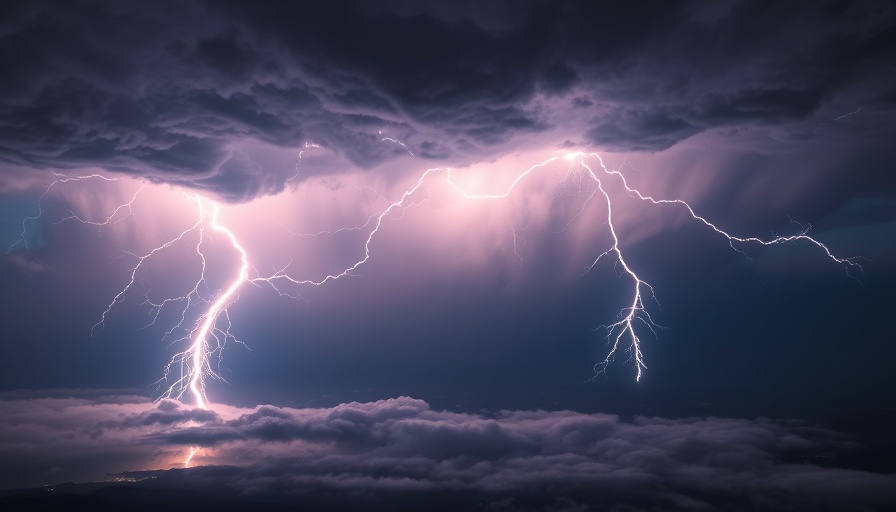
A Record-Breaking Lightning Bolt Redefined
In a startling meteorological event, scientists recorded a jaw-dropping 515-mile lightning bolt that lit up the skies from eastern Texas to Kansas City. This unprecedented occurrence, known as a ‘megaflash,’ has not only set new records but also reshaped our understanding of extreme weather phenomena. State-of-the-art satellite technology has played a crucial role in capturing and analyzing this colossal discharge, allowing researchers to delve deeper into the mechanics of such powerful natural events.
Understanding Megaflash Lightning
The term ‘megaflash’ refers to lightning strikes that span immense distances, much beyond what was previously considered possible. Dr. Randy Cerveny, a prominent meteorologist at Arizona State University, noted, “We call it megaflash lightning, and we're just now figuring out the mechanics of how and why it occurs.” This particular event surpassed the previous record of 477 miles set during an April 2020 storm, a feat that remained unnoticed until engineers revisited satellite observations from a major thunderstorm that had occurred back in October 2017.
Rapid Technological Advancement in Weather Monitoring
The successful detection of this megaflash could only be made possible through space-based instruments that have evolved significantly. Traditionally, lightning detection has relied on ground-based networks of antennas that estimate lightning location by analyzing radio signals. However, the advancements brought by satellites, equipped with geostationary lightning mappers since 2017, have transformed how meteorologists track storms. The National Oceanic and Atmospheric Administration's (NOAA) GOES-16 satellite, for example, continuously detects around one million lightning events each day and significantly improves the ability to understand and predict extreme weather.
Implications for Extreme Weather Prediction
Lightning of this magnitude poses dangers, even in clear weather. Dr. Cerveny highlighted how additional high-quality measurements can reveal even more extreme weather events, suggesting that the potential for discovering larger megaflashes is plausible as technology continues to improve. This advancement not only enhances forecasting accuracy but also offers essential insights into climate change and extreme weather’s role in our evolving environment.
The Risk Factors and Challenges of Megaflashes
While the spectacle of megaflash lightning is certainly captivating, it raises valid concern for safety and preparedness in affected regions. Understanding the risk factors associated with these extreme lightning strikes is paramount, particularly as climate data indicate possible increases in storm intensity. Collaboration among meteorological institutions globally is essential to share findings and develop improved predictive models.
Future Predictions and Insights
As scientists gather more data from evolving satellite technology, we should expect innovations in thunderstorm tracking, making forecasting more reliable. Improved satellite detection not only helps in emergency preparedness but also aids in advancing our comprehension of global weather patterns, potentially mitigating catastrophic effects of severe storms.
The implications of this cutting-edge research extend beyond the realm of meteorology; they influence urban planning and emergency services, particularly in regions like Dallas, Texas. With its vibrant lifestyle and growing urban environment, understanding weather patterns can play a crucial role in effective city management.
The Human Element: Making Sense of the Science
Living in areas prone to extreme weather events can stir mixed feelings. Residents of Dallas, familiar with severe thunderstorms, must be aware of the challenges and risks associated with living in such climatic conditions. As with other major cities, the cost of living in Dallas necessitates a comprehensive understanding of environmental issues, showcasing the delicate balance between enjoying city life and staying informed about natural phenomena.
Conclusion: The Need for Awareness and Preparedness
As we continue to uncover the mysteries behind megaflashes, it is crucial to cultivate a culture of awareness and preparedness. By understanding the dynamics of extreme weather, residents can better prepare for potential impacts in their area.
Stay informed about extreme weather and learn how to prepare your home and family for such phenomena through local resources and community outreach.
 Add Element
Add Element  Add Row
Add Row 



Write A Comment